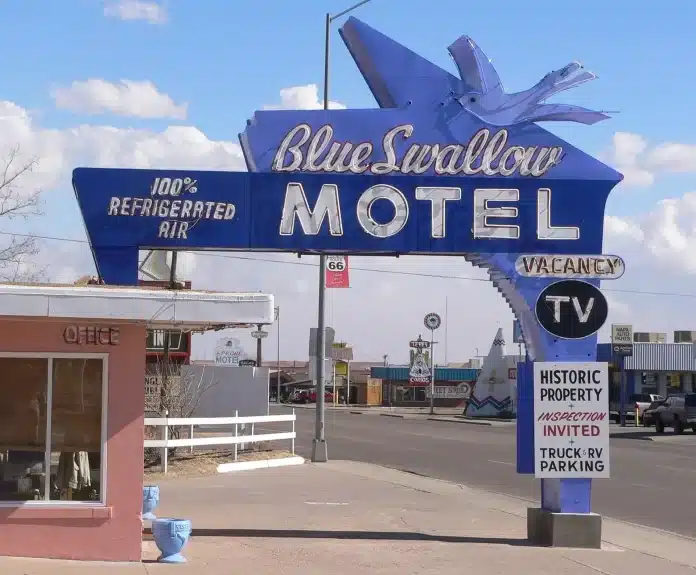If, as John Cheever once noted, America’s train stations and air terminals are its true cathedrals, motels may be it’s shrines. And if not part of America’s soul, they are certainly part of its circulatory system. Or they were—but I’ll get to that later. The motel was one consequence of the mass-produced automobile, beginning with Henry Ford’s Model T, which gave average citizens the means to chuck—however temporarily—a mundane, shackled life and, as expressed by one of the most resonant phrases in American English, “hit the road.” By the nineteen-teens, many could use their vacations to motor into America’s tradition of nomadic independence, traveling well off the crowded and beaten tracks of mass transportation. Theoretically at least, they could go anywhere in their vast country, at any hour they pleased, for a week or so. Pile the family into the flivver, and it was Goodbye Grundy Center, hello St. Louie. They were pioneers, voyageurs, desperadoes. Escape from the humdrum—the true American Dream.
At first, people needed outdoor gear, for what came to be called “auto camping,” which involved simply pitching a tent by the roadside at night or, later , stopping at a public camp ground. The romantic term for this kind of travel was “gypsying” or “hoboing” (putting aside the fact that real hoboes preferred to take the train). But then, one fine day, at the end of 200 or so sweltering, noise polluted, kidney-tilting miles, behold: backlighted by a Horse Cave, Kentucky, sunset, there it was—Wigwam Village, a set of nine identical cabin-sized cones made of steel, wood, and canvas, arranged to look like a Native American campground, including rest rooms for “squaws” and “braves.” It was one of the earlier motels, built in 1933, when they were often known by such terms as “tourist cabins,” “auto courts,” or “motor hotels.” Scholars disagree on when the first motel appeared, but by 1935 America boasted nearly 10,000, and that was just for starters.
But what distinguished a motel from a hotel, besides the device known as “Magic Fingers,” which, as I recall from my childhood, would make the bed vibrate noisily for about 10 minutes, when it worked? So what if nothing even close to magic or even fingers was involved: it smacked of Scheherazade, and it only cost a quarter. In their heyday, over 250,000 Magic Fingers pulsated bedsprings along America’s highways. But motels involved more than a vibrating bed. Originally, a motel was a place where you could drive right off the highway and up to your room, without having to deal with snooty bellhops and valets. Add to those features the regular sound of trucks blasting by, headlight beams sweeping back and forth behind oilcloth drapes that would never quite close, and, after someone got the bright idea of joining all the cabins into one unit, walls that seemed thin enough to function as giant speaker diaphragms. If your lodging included all or most the above, you knew you were in a motel. The writer Denis Johnson has pinpointed the essence of motel room décor as that which makes the room still seem vacant when you’re inside. But if the décor was often stark and the architecture an afterthought (with some exceptions like those motels built in a style called “Streamline Modern”), most motels had their own identities, thanks to some little touches here and there—if only a weird paint job or a stuffed bird collection. And though many were named after their owners or fancy hotels—the Ritz, the Plaza—there evolved the uniquely motel name. Ever run across a hotel called The No-Tell? The Covert? The Air-O-Tel ? the Bo-Peep? The Lame Duck? Or, my favorite, The Purple Heart, with its dual suggestion of romantic passion and combat wounds? Not a chance. There was also the distinctive bouquet de motel of stale cigarette smoke, carpet mold, toilet sanitizer—and beneath that, a soupcon of diesel fumes and feet.
One other important distinction: The motel was usually near or outside the city limits and was constructed and operated to offer greater freedom and privacy than the busier, more supervised hotel. Consequently, it wasn’t long till the family-oriented ambience of the motel became mixed with something darker. “What better place to take my girl for some heavy petting?” some horny 1920’s college kid must have realized. “What better place to have an affair?” someone else thought. Then those others must have joined the brainstorming, the ones who asked, “What better place to take a break while fleeing an interstate police dragnet?” or to go where no one else has ever gone with rubber, leather, and handcuffs? Or to saw that cumbersome dead body into something suitcase-size?” And so, motels became, at least in the words of a young J. Edgar Hoover, “camps of crime,” or, more popularly and colorfully “hot pillow joints.” Add to the pot the traveling salesman’s discovery of this cheaper, more convenient place to stay and the motel’s distinctive profile is complete.
And wouldn’t you know the arts would stick their noses into the motel’s shadier aspects. Where did Gable and Colbert go in the film It Happened One Night to pull down what they called the “Walls of Jericho”? Where was Norman Bates inspired to make Mom proud and easy to store? Don’t forget that scene in Bonnie and Clyde, where Warren Beatty and Fay Dunaway reenact the real Barrow family’s tourist cabin shootout with the cops. And what do you recall goes on in the famous motel scene in Orson Wells’ Touch of Evil or in the cult classic Motel Hell? But it wasn’t just the movies. Humbert took Lolita to a motel (there were also two movies of that book). As for musical influences, just punch up “motel” on the All Music Guide web site, and you’ll find songs like “Motel Sex,” “Motel Party Baby,” “Motel Street Meltdown.” There’ve been enough similarly-titled poems about motels written in this country to make a genre. And don’t you get the feeling there’s something creepy going on just out side the frame in Edward Hopper’s painting of that woman sitting in a motel room with a Buick Road master staring in the window?
But despite, or perhaps partly because of the real and imagined dark sides, motels remained popular outposts for middle-class America’s escape onto the open road. If the people in the next room looked a little feral, so much heartier the adventure.
In 1954, my family and I experienced what turned into a total-motel vacation. We were going to drive to the Grand Canyon from our home in Omaha. However, being shut up 10 hours a day in a small compartment with his whole family became too much for my father. A mere one hundred miles from our destination, following through on a threat he’d uttered earlier, he turned back, completing the first half of a connect-the-dots, motel to motel foray, from The Big Chief to The Rio Siesta and on and on, including one my father described as being “as close to hell as I ever want to be.” And he’d been in the War. What vacation could be more American?
But for children, motel stops were often the highlight of vacation traveling. Grim as it might have been, the Cactus Motel-Camp could seem like an oasis after spending the day in the back seat rereading comic books and being told, alternately, to stop shoving little sister and stop kicking the back of Daddy’s seat. What former kid can’t recall the amusingly empty threat that “If you keep that up, I’m going to turn this car around right here, and we’ll go home!” Well, empty most of the time. But lets face it : to most kids, a dip in a brackish swimming pool after two bottles of orange Neha from a rusty, top-opening soda machine bested any number of so-called natural wonders. Add to that a snowy, flickering Lucy rerun on a rabbit-eared TV in a room rich in what was termed “refrigerated air,” then top it all off with a bedtime ride on the Magic Fingers magic carpet, and could Munchkins be far behind?
Of course if you’ve stayed in a motel lately, all of this must sound a little unfamiliar. That’s because of two developments, both of which began escalating in the early 1960’s: the interstate highway system and the Holiday Inn corporation. Remember the problem Norman Bates had at the beginning of Psycho? The Bates Motel was usually vacant.
Because almost all the traffic took the “new highway,” no doubt an interstate. Norman and the other independent moteliers were not only bypassed by the interstates but, due to limited-access regulations and, later, Lady Bird Johnson’s campaign against highway clutter, they were often prohibited from putting up signs to tell motorists where to find them. No problem, of course, for the wealthy and influential Holiday Inn and copy-cat mega-franchises, who have tamed the motel into something safe, clean, efficient, and, of course, standardized. Signs aplenty for them. Motels have been made part of what’s called “the hospitality industry,” and most of the ones common folk can afford to stay in are as boring and interchangeable as industrially carpeted cinder blocks, the last places you would associate with “gypsying.” And the line between hotels and motels has gone wobbly at best. You can now find a 10-or-more-story Holiday Inn in the middle of practically any American city. Most of the incorporated motels, which now cater mainly to corporate customers, don’t even use the m-word, preferring that substitute which offers an absolutely false implication of comfy intimacy among traveling strangers. Would Chaucer’s pilgrims have been so relaxed and chatty starting out from the Airport Comfort Inn?
So, though you can still find authentic motels in any of the 50 states, they’re disappearing into pop culture history, along with America’s most motel-friendly highway, our beloved Route 66. But don’t blame Lady Bird or Holiday Inn. We’re the ones who, even in the days of tourist cabins, kept choosing comfort, cleanliness, and reliability over a little roughness, grunge, and adventure. Now, on the interstate, it’s often hard to tell what state you’re in without looking at the small print on the standardized red-and-blue signs. Even the signs that tell you what gas stations restaurants, and motels, are ahead are standardized, as are most of the gas stations, restaurants, and motels. The day may come when you can pull your lozenge-shaped auto up to an interstate McDonalds anywhere in the country and be served by a red-haired, affable kid named, let’s say, Tim, who’ll give you the same polite howdy in Poukeepsie that he did in Minot. When he greets you by name and asks what it’ll be, all you’ll have to say is, “The usual, Tim.” He’ll be electric, of course. Maybe you’ll be, too. So farewell, Purple Heart. Adios, Wigwam Village. We wish we could have been better gypsies.
***
Our friends at Circe have launched an anti-advice column, and it is fire!
Click above to get details on how to ask Gina and Emily for advice and let us know what you think!
***

